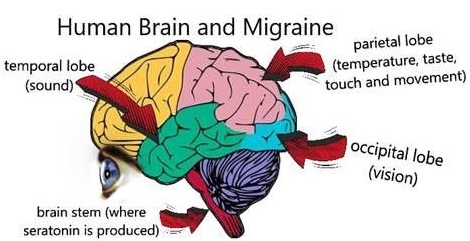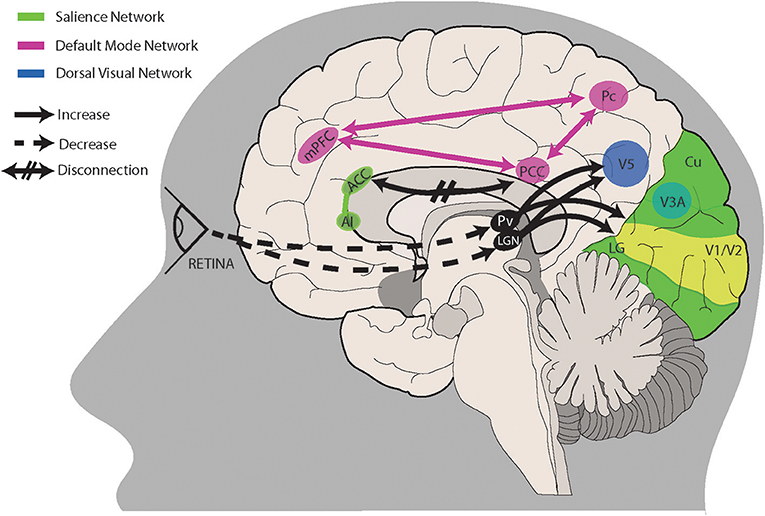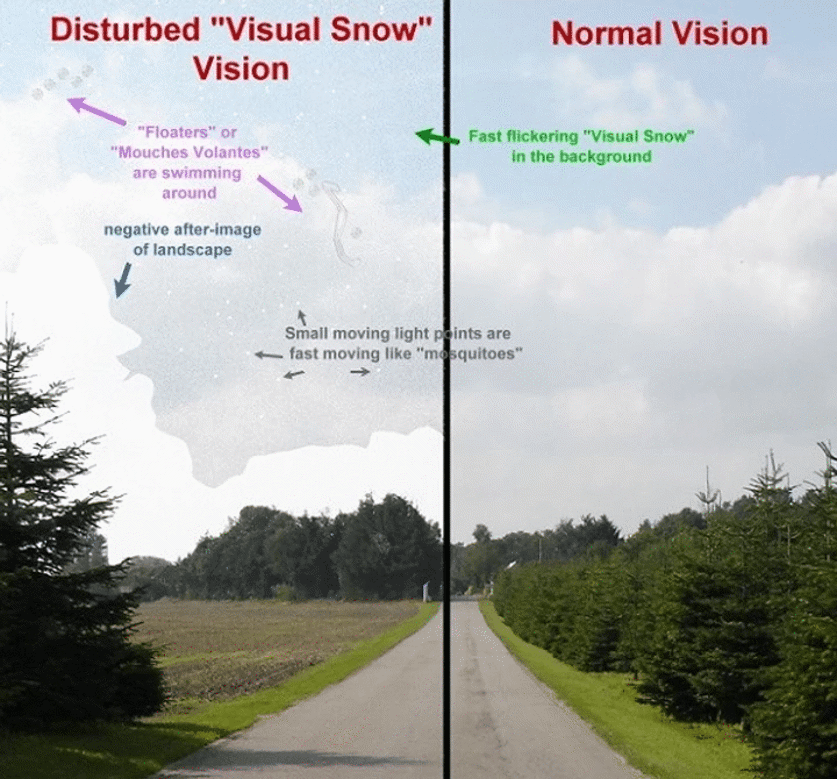Flickers are sparkles that shimmer in vision ("scintillations") Flickers usually come from activated visual cortex in migraine, but importantly also in transient ischemic attack, seizure, damaged retina, and damaged optic nerve.

- Flashes are bright sparks or streaks of light that appear suddenly and briefly in vision
- Flashes usually come from tugging on retinal photoreceptors, which may signal impending or actual vitreous detachment, retinal hole, or retinal detachment
- Flickers are sparkles that shimmer in vision ("scintillations")
- Flickers usually come from activated visual cortex in migraine, but importantly also in transient ischemic attack, seizure, damaged retina, and damaged optic nerve

Ocular migraines vs. migraine auras - Flashes appear abruptly like lightning bolts in outer edge of visual field
- Flashes may be provoked by eye movement
- Flickers may be transient or persistent
- Flickers that are part of visual aura of migraine often expand across hemifield in 20-30 minutes and disappear
- Flickers of migraine usually precede headache and other manifestations
- Flickers of damaged retina or optic nerve are often persistent
In visual perception, flicker is a human-visible change in luminance of an illuminated surface or light source which can be due to fluctuations of the light source itself, or due to external causes such as due to rapid fluctuations in the voltage of the power supply (power-line flicker) or incompatibility with an external dimmer. eResearch by Navid Ajamin -- summer 2024
What is a migraine?
Migraine is a neurological condition that is characterized by often incapacitating symptoms including severe, throbbing and recurring pain that’s usually centered on one side of the head.
Other disabling symptoms of a migraine are nausea, vomiting, dizziness, tingling or numbness in the extremities or face, and extreme sensitivity to sound, light, touch and smell.
Migraine affects about 1 billion men, women and children worldwide and approximately 40 million Americans.
Migraine headaches can last up to three days and produce moderate to severe pain.
Migraines are most common between the ages of 18 and 44, and they affect women disproportionately. Eighteen percent of American women suffer from migraines, compared to 6 percent of men and 10 percent of school-age children.
There is a strong genetic link for migraines, with about 90 percent of sufferers reporting a family history of these headaches.
Migraine is a "diagnosis of exclusion," which means it is reached by a process of elimination since there is no test or biomarker to confirm its presence.
Just as every person is unique, so are migraine headaches. Migraines differ from person to person, and migraines also can present in different ways and with different symptoms in the same person.
Retinal migraine is a retinal disease often accompanied by migraine headache and typically affects only one eye. It is caused by ischaemia or vascular spasm in or behind the affected eye.
The terms "retinal migraine" and "ocular migraine" are often confused with "visual migraine", which is a far-more-common symptom of vision loss, resulting from the aura phase of migraine with aura. The aura phase of migraine can occur with or without a headache. Ocular or retinal migraines happen in the eye, so only affect the vision in that eye, while visual migraines occur in the brain, so affect the vision in both eyes together. Visual migraines result from cortical spreading depression and are also commonly termed scintillating scotoma.

Migraine aura
A migraine aura starts in your brain, not your eye. The aura is one or more symptoms that can happen right before a headache starts. These visual symptoms happen in both eyes.
Migraine with aura (also called classic migraine) is a recurring headache that strikes after or at the same time as sensory disturbances called aura. These disturbances can include flashes of light, blind spots, and other vision changes or tingling in your hand or face.
Treatments for migraine with aura and migraine without aura (also called common migraine) are usually the same. You can try to prevent migraine with aura with the same medications and self-care measures used to prevent migraine.
Symptoms
Migraine aura symptoms include temporary visual or other disturbances that usually strike before other migraine symptoms — such as intense head pain, nausea, and sensitivity to light and sound.
Migraine aura usually occurs within an hour before head pain begins and generally lasts less than 60 minutes. Sometimes migraine aura occurs without headache, especially in people age 50 and older.
Visual signs and symptoms

Most people who have migraine with aura develop temporary visual signs and symptoms, which tend to start in the center of the field of vision and spread outward. These might include:
- Blind spots (scotomas), which are sometimes outlined by simple geometric designs
- Zigzag lines that gradually float across your field of vision
- Shimmering spots or stars
- Changes in vision or vision loss
- Flashes of light


Some people experience an aura without any pain at all. Doctors call this an “acephalgic migraine” or a “migraine aura without headache.”
It's also common for people to call them "visual migraines." This may be why they get mixed up with ocular migraines so often. Here is an easy way to remember the difference: "visual migraines" happen in your vision, but "ocular migraines" happen in your eye.
About 8% of the population gets migraines with aura.
One in every four people who get migraines sees an aura beforehand. Others will only experience symptoms like headache, nausea and vomiting.
- Refer patient with flashes urgently to ophthalmologist because they suggest intraocular disorder (vitreous, retina, optic nerve)
- Refer patient with flickers urgently to ophthalmologist, neuro-ophthalmologist or neurologist unless diagnosis of migraine is obvious because they could also suggest transient ischemic attack or seizure
- Vitreous detachment may rarely cause retinal tear and detachment which must be repaired promptly to protect vision
- Visual aura of migraine is usually harmless, but transient ischemic attack and seizure have health consequences

How do I tell the difference between aura and stroke?
Strokes produce visual, sensory and/or speech symptoms almost instantaneously, and most frequently they are “negative” phenomena—that is, a loss of vision, numbness or weakness. Also with strokes, there is no sense of movement of the phenomena to other parts of the body. They don’t progress but are maximal at onset. Strokes usually are continuous and do not remit in one hour. A headache may or may not occur with a stroke. In addition, an aura occurring for the first time after the age of 40, with numerous vascular risk factors such as hypertension, diabetes and hyperlipidemia, should be investigated for transient ischemic attacks. If the visual symptom is ONLY negative (that is, a hemianopic scotoma), the person should be further investigated.
A migraine is a recurrent and severe headache which a whopping one in ten New Zealanders suffer from.
There are a few different types of migraines which people usually experience:
- A classic migraine occurs in about 40% of migraine sufferers and has an aura (visual, auditory, olfactory or tactile).
- A common migraine occurs in about 60% of migraine sufferers and has no aura.
- A silent migraine is when a person experiences the aura, but no headache or pain afterwards.
- A visual migraine is a silent migraine when the aura is visual.
- A retinal migraine is very rare and its visual symptoms are the partial or total loss of vision, temporarily in one eye. In recurrent cases, it is most likely to affect the same eye each time. The vision fades out over five minutes, and can be described as a dimming of vision, flashes of light or patches of blank spots (scotomas) that enlarge to block out all sight in that eye. The vision returns to normal within an hour. This loss of vision is caused by reduced blood flow or spasms of the blood vessels in the retina or behind the eye, not in the brain.

Migraines might occur rarely, once or twice a year, or they could strike several times a month. The frequency differs drastically between sufferers and is often associated with an underlying cause. Migraines usually run in families as they have a genetic component. People with two parents who suffer from migraines have a 75% chance of having migraines themselves. Women are also three times more likely than men to get them.

Reference:
- denarend.com/miscellaneous
- en.wikipedia.org/wiki/Retinal_migraine
- allaboutvision.com/conditions/migraine-aura
- allaboutvision.com/conditions/ocular-migraine.htm
- kellogg.umich.edu/theeyeshaveit/common/flashes_flickers.html
- mayoclinic.org/diseases-conditions/migraine-with-aura/symptoms-causes
- wefixeyes.co.nz/articles/the-relationship-between-eyesight-and-migraines
- americanheadachesociety.org/wp-content/uploads/2020/08/AHS-First-Contact-Migraine-w-Aura.pdf


 وبلاگ تخصصی عینک شامل مجموعه مطالب پزشکی است که اطلاعات مفیدی در رابطه با عینک , چشم، لنز، سلامتی چشم و راه های پیشگیری از بیماریهای چشمی، کنترل و درمان آن را در اختیار شما کاربر محترم می گزارد.
وبلاگ تخصصی عینک شامل مجموعه مطالب پزشکی است که اطلاعات مفیدی در رابطه با عینک , چشم، لنز، سلامتی چشم و راه های پیشگیری از بیماریهای چشمی، کنترل و درمان آن را در اختیار شما کاربر محترم می گزارد.